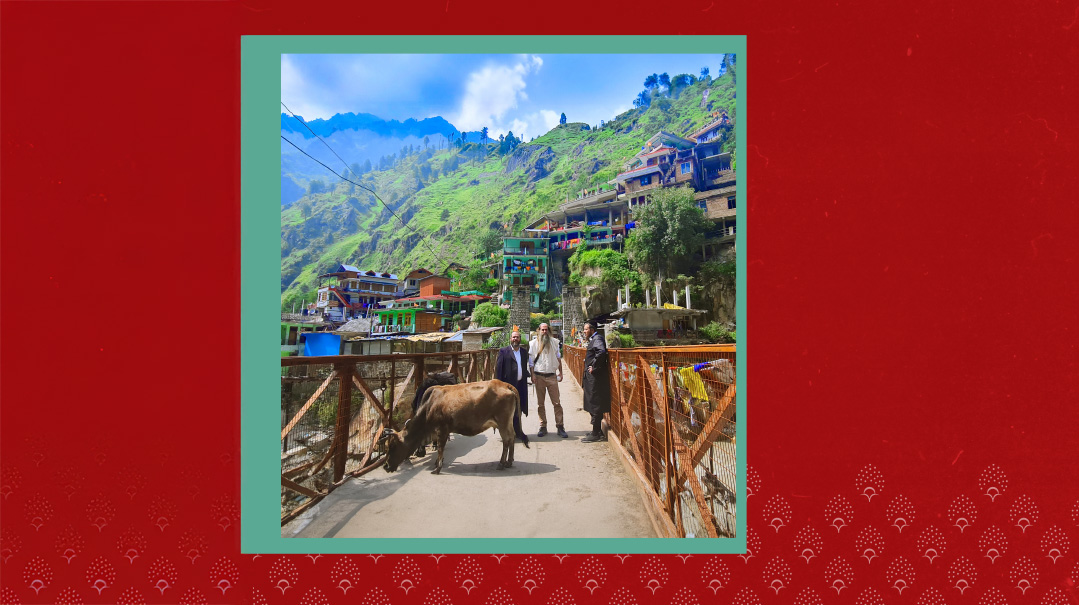Never Too Far
| October 13, 2024A Breslov family gives more than food in a primitive Indian village

Photos: Yehuda Sagir
By Yisrael A. Groweiss and Aharon Kliger, Pulga, India
In a remote, rundown village under the hulking shadow of the Himalayas, a family of Breslover shluchim provides Israeli backpackers with food, shelter, and the acceptance they crave. Tapping the timeless wisdom of Rebbe Nachman of Breslov, they speak directly to the scarred souls that trek through the Far East in an effort to escape their tortured pasts — and on a quest to discover their very essence
Four toothless mouths. That’s what I see from the window of the small Fiat transporting Aharon Kliger and me to our destination. Collectively they emit a babble of syllables that sound like a cross between shevarim and teruah. The only one who’s able to decipher their babbling is our driver. After a few seconds, he joins the cacophony.
Before we manage to grasp what is going on, he silences the engine and claps his hands together. This is his way of telling us we’ve arrived.
Where to, exactly?
He points to a gravel path. We have reached the literal end of the road. No vehicle can traverse the final leg of our journey; in order to reach our destination — a remote village in Northern India — we’ll have to travel on foot.
After a two-hour, bone-jarring ride in the tiny Fiat, a walk doesn’t sound so bad. Our legs could definitely use a good stretch. And the scenery is heart-stoppingly beautiful. The wonders of creation are on dazzling display here as the Himalayas rise up ahead, with green expanses, dark slopes, and snowy peaks protruding through the clouds.ruachBut are we really supposed to climb the gravel mountain path by foot along with our suitcases? The driver doesn’t understand our hesitance. He points to the foursome of toothless geriatrics. “You walk on road,” he says in stilted English. “Here are porters. They take suitcase.”
Our hearts sink. Are these elderly, skeletal porters really supposed to schlep our luggage? The youngest of the group looks like he’s in his eighties. I wouldn’t trust him to carry a bowl of hot cholent.
But before we can collect our wits, it’s all been arranged. The foursome conduct fierce negotiations about who will get the job of carrying our belongings. Finally, one of them prevails — an elderly grandmother. After schlepping our luggage up the rocky road and climbing three more inclines, she will earn a small fortune: 200 rupees, a bit over two dollars.
The elderly woman produces a thick rope and ties the two suitcases together. She lies down and another old man loads them onto her back. And then she stands herself up and begins to climb steadily up the path.
Apparently, holding valises while finding footholds amid the rocks is all in a day’s work for our porter — but we’ve never seen a road quite like this one. On one side is a frightening abyss, on the other side, craggy cliffs. Lining the narrow path is a hodge-podge of tin huts and wooden structures painted in bright, lively colors.
There may be no cars here, but at one juncture, we find a serious traffic situation. A convoy of donkeys is coming from one direction, a group of oxen from the other. Bellowing and braying can be heard on both sides, along with some barking from stray dogs. We stand watching the bizarre traffic jam, with our elderly porter before us, knots of barefoot children around us, and swarms of flies buzzing lazily around our heads.
We think of our families back home and wonder why we’ve been so foolhardy as to take this trip through the Indian backwater. And then suddenly, our hearts expand.
There, amid the chaos, we spot a sign with Hebrew letters reading, “Habayit Hayehudi-Ruach Acheret.” A man emerges from among the cliffs, bearing a huge smile and an even larger yarmulke. His peyos and tzitzis sway in the wind. His arms wave in greeting. “Bruchim habaim,” he announces.
And just like that, our anxiety dissipates. “My dear brothers,” Moshe Sagir says with two outstretched arms. “Welcome to Pulga.”
This, I think, must be how Avraham Avinu’s tent looked: an oasis broadcasting security and welcome, just with four openings.
We enter the house and the old woman collapses to the floor, utterly spent. We hurriedly give her a drink and then, when she’s ready to go on her way, pay her double the agreed-on fee.
On the second floor of the Bayit Hayehudi there’s a small room. “Come inside,” says Reb Moshe Sagir, the man who has moved here earlier this year with his wife Rumiya and their eight children. “This is my private beis medrash.” We enter. Inside we find a small aron kodesh, paroches, and a bookcase full of seforim and pamphlets.
You’d have to see it to believe it: a proper Jewish home, complete with its own small shul, right in the middle of a region reeking of idol worship. Here in remote Pulga, under the gentle guidance of Moshe and Rumiya Sagir, hundreds of Jews are kindling their inner spark.
It’s a new twist on an ancient goal: “To make for Hashem a dirah batachtonim, a dwelling place in this world.” There may be no part of the world as steeped in impurity as the region we’re in. But somehow the Sagirs have managed to construct a home where Hashem is welcome.
Oops! We could not locate your form.







